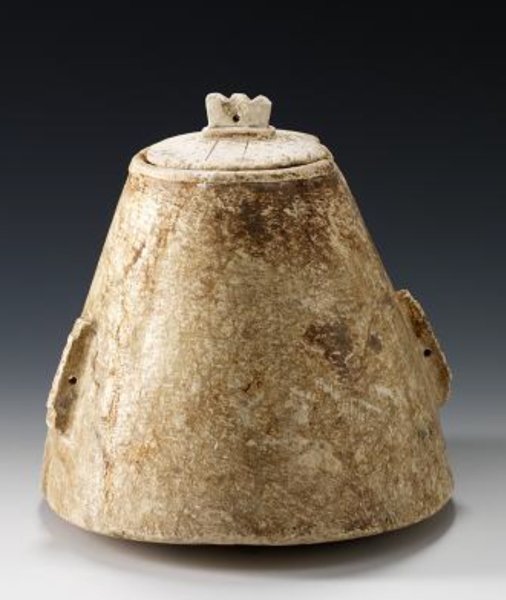
The Limestone Vessel is a conical-shaped container carved from limestone. It was discovered in Qaryat al-Faw Archaeological Site, one of the historically significant locations rich in discoveries. It is located southeast of Wadi ad-Dawasir Governorate, at the intersection of Wadi ad-Dawasir and the Tuwaiq Mountains, in the Riyadh Province of the Kingdom of Saudi Arabia.
Description of the vessel
The limestone vessel widens at the bottom and narrows toward the top. It features a narrow mouth with a slightly outward-protruding rim and a round lid with a handle. The upper edge of the lid is stepped, with a central circular perforation. The outer surface of the lid is adorned with a series of intersecting grooves. The vessel is equipped with two prominent rectangular handles carved in relief and fixed vertically. Each handle features a central circular perforation and is engraved with horizontal lines. Around the lid's circumference are small geometric circles, each containing a faint central dot. The interior surface of the vessel shows remnants of date pits, and visible wear can be observed on the rim of its mouth.
Dimensions of the vessel
Base of the vessel: 22.5 cm.
Mouth diameter: Nine cm.
Height of the vessel: 18.5 cm.
History of the vessel
The limestone vessel dates back to between the third century BCE and the third century CE. It was used for preserving and storing dates.
The limestone vessel is registered under the number 75 F 20. It is preserved at the Museum of the Department of Archaeology at King Saud University in Riyadh, which features a dedicated section for artifacts and discoveries from the historical Qaryat al-Faw. It was selected as part of a diverse collection of archaeological discoveries showcased in the Saudi Archeological Masterpieces Through the Ages Exhibition, first held at the Louvre Museum in Paris in 2010. The exhibition subsequently toured various countries worldwide. The vessel's discovery is among the findings of archaeological surveys and excavation efforts conducted by the antiquities and museums sector in Saudi Arabia over the past years, as well as discoveries made by Saudi archaeologists and scientific expeditions.
Significance of the vessel
This conical vessel reflects the ability of the people of the Arabian Peninsula to create items that met their needs by crafting containers designed for specific functions. It was crafted for storing and preserving dates.
Related quizzes
Related articles

